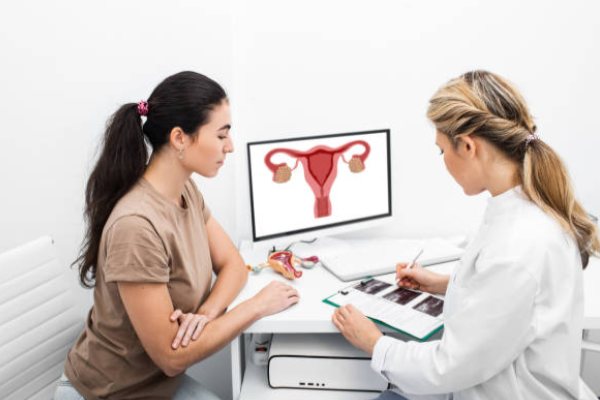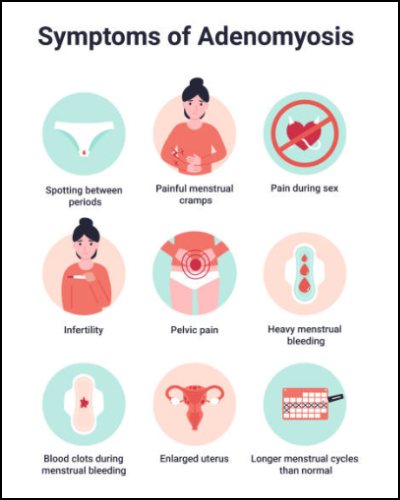What Is Adenomyosis? How Is Adenomyosis Diagnosed and Treated?

Adenomyosis is a common but often misunderstood medical condition that can cause significant discomfort and pain for those who suffer from it. This condition primarily affects women of childbearing age and is characterized by the abnormal growth of tissue from the uterine lining (endometrium) into the muscular wall of the uterus (myometrium). As a leading healthcare provider, AMVI Hospital is dedicated to raising awareness about adenomyosis and helping women understand its diagnosis and Adenomyosis treatment options.
Symptoms of Adenomyosis
Adenomyosis is a condition that can lead to various symptoms, including:
- Menstrual Pain: Women with adenomyosis often experience severe menstrual cramps that may not respond well to over-the-counter pain relievers.
- Heavy Menstrual Bleeding: Excessive menstrual bleeding is another common symptom of adenomyosis, which can lead to anemia over time.
- Pelvic Pain: Many women with adenomyosis suffer from chronic pelvic pain, which can be debilitating and impact their quality of life.
- Painful Intercourse: Adenomyosis can also cause discomfort or pain during sexual intercourse.
- Painful Bowel Movements: In some cases, the presence of adenomyosis can result in discomfort or pain during bowel movements, particularly during menstruation.
- Frequent Urination: Adenomyosis can cause increased pressure on the bladder, leading to more frequent urges to urinate.

Diagnosing Adenomyosis
Diagnosing adenomyosis typically involves a combination of medical history review, physical examination, and imaging tests. Here's how doctors at AMVI Hospital diagnose this condition:
- Medical History and Physical Examination: Your healthcare provider will inquire about your symptoms and perform a physical examination. They will check for any abnormalities in your pelvic area.
- Ultrasound: Transvaginal ultrasound is a common initial imaging test used to visualize the uterus and detect any abnormalities. However, it may not always provide a definitive diagnosis.
- MRI (Magnetic Resonance Imaging): In some cases, an MRI may be recommended to get a more detailed view of the uterus. MRI can help differentiate adenomyosis from other uterine conditions.
- Hysteroscopy: A hysteroscope is a thin, flexible tube with a camera that is inserted through the cervix into the uterus. It allows doctors to directly view the uterine lining and detect adenomyosis.
- Biopsy: In rare cases, a biopsy of the uterine tissue may be necessary to confirm the diagnosis.

Treatment Options for Adenomyosis
Once adenomyosis is diagnosed, the next step is determining the most appropriate treatment plan. The choice of treatment depends on the severity of symptoms, the patient's age, and their desire for future fertility. At AMVI Hospital in Puppalaguda, we offer a range of treatment options, including:
- Pain Management: Over-the-counter pain relievers or prescription medications may be used to manage pain and discomfort associated with adenomyosis.
- Hormonal Therapy: Birth control pills, hormonal intrauterine devices (IUDs), or hormonal injections can help regulate menstrual cycles and reduce symptoms.
- Uterine Artery Embolization (UAE): UAE is a minimally invasive procedure that blocks the blood supply to the uterus, reducing symptoms such as heavy bleeding and pain.
- Myomectomy: In cases where adenomyosis causes the formation of masses (adenomyosis), a Laparoscopic myomectomy surgery can be performed to remove these growths while preserving the uterus.
- Hysterectomy: For severe cases or when other treatments have failed, a hysterectomy (removal of the uterus) may be recommended. This is a definitive solution but results in infertility.
What Things Should Be Kept in Mind After Adenomyosis Treatment?
After undergoing treatment for adenomyosis, it's essential to take proper care of yourself to ensure a smooth recovery and minimize the chances of recurrence or complications. Here are some important steps to consider:
- Follow Medical Advice: Adhere to your healthcare provider's recommendations diligently. Attend all follow-up appointments, take prescribed medications as directed, and communicate any concerns or changes in your condition promptly.
- Monitor Symptoms: Keep track of any new or recurring symptoms. If you experience unusual pain, heavy bleeding, or other concerning signs, report them to your doctor immediately.
- Healthy Lifestyle: Maintain a balanced diet rich in nutrients and fiber. Regular exercise can also help with overall health and well-being. Avoid smoking and limit alcohol consumption.
- Stress Management: Stress can exacerbate adenomyosis symptoms. Practice stress-reduction techniques such as deep breathing, meditation, yoga, or mindfulness to promote relaxation.
- Stress Management: Stress can exacerbate adenomyosis symptoms. Practice stress-reduction techniques such as deep breathing, meditation, yoga, or mindfulness to promote relaxation.
- Birth Control: If you were prescribed hormonal birth control as part of your treatment, use it as directed to regulate your menstrual cycle and reduce symptoms.
- Pain Management: Over-the-counter pain relievers like ibuprofen can be used as directed to manage any residual pain or discomfort. Always consult your doctor before taking any new medications or supplements.
- Pain Management: Over-the-counter pain relievers like ibuprofen can be used as directed to manage any residual pain or discomfort. Always consult your doctor before taking any new medications or supplements.
- Nutritional Supplements: Some individuals find relief from adenomyosis symptoms by taking certain nutritional supplements. Discuss this with your healthcare provider before adding any supplements to your routine.
- Stay Informed: Continue to educate yourself about adenomyosis and stay informed about any advancements in treatment options or research related to the condition.
- Fertility Considerations: If you have concerns about fertility, discuss them with your healthcare provider. Depending on your treatment and personal goals, you may want to explore family planning options.
- Support Network: Lean on friends and family for emotional support during your recovery. Consider joining support groups or seeking counseling if you find it helpful to share your experiences with others who have adenomyosis.
- Regular Check-Ups: Even after successful treatment, it's important to have regular check-ups with your healthcare provider to monitor your condition and ensure it doesn't return.
- Be Patient: Recovery from adenomyosis treatment can take time. Be patient with yourself and allow your body the time it needs to heal fully.
Remember that everyone's experience with adenomyosis is unique, so what works best for one person may not be the same for another. Your healthcare provider is your best source of guidance, so maintain open communication and seek their advice whenever needed. By taking these post-treatment precautions, you can enhance your overall well-being and minimize the impact of adenomyosis on your life.
Conclusion
Adenomyosis is a challenging condition that can significantly impact a woman's life, but with early diagnosis and appropriate treatment, it is manageable. If you are experiencing symptoms like severe menstrual pain, heavy bleeding, or pelvic discomfort, it's essential to seek medical attention promptly. At AMVI Hospital, our expert team of gynecologists and specialists is dedicated to providing the highest quality care and helping you navigate your options for adenomyosis diagnosis and treatment. Don't let adenomyosis disrupt your life – contact us today for expert guidance and support.
Leave a Reply
Your email address will not be published. Required fields are marked *








